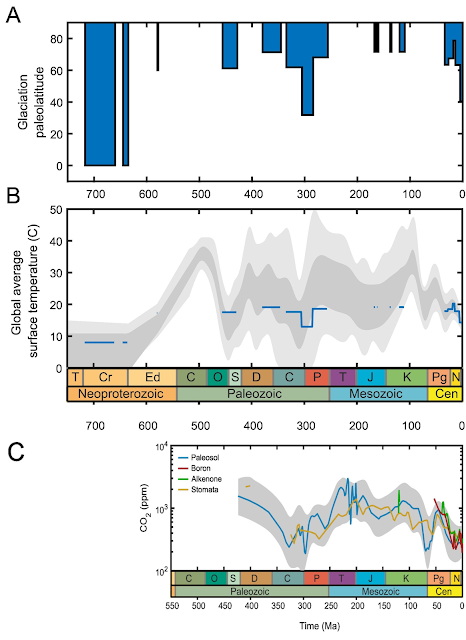Comparing CO2 Forcings and Temperature in the Geologic Past
For over 20 years, geologists have attempted to model CO2 concentrations across the geologic past. Geologists currently have sufficient proxy evidence to reconstruct CO2 concentrations for significant parts of the last 420 million years, but models can be useful to infer concentrations when proxy evidence is weaker or lacks sufficient resolution. While "box" models like COSPE or GEOCARBSULF confirm broad correlations between CO2 and global temperatures, the correlation may be improved if the models take better account of tectonic processes affecting CO2 concentrations.
Evaluation of Proxies for CO2 and Temperatures
In a study published three years ago, Mills et al 2019 evaluated the performance of CO2 proxies as well as COPSE and GEOCARBSULF "box" models for CO2. The latter model is the most recent update to the GEOCARB model that is frequently misused in contrarian graphs of CO2 and temperature - GEOCARBIII was published in Berner 2001 and is often plotted with an old schematic of temperature from Christopher Scotese (a coauthor in this study). The evaluation began by assessing the correlation in proxies for CO2 and global temperature.
 |
| Paleo Temperature Reconstruction from δ18O proxies and glaciation |
Mills et al compiled a reconstruction of global temperatures for the last 750 million years using combined δ18O and glaciation records. The results are above. Next they reconstructed the available CO2 proxy evidence to reconstruct CO2 concentrations for the last 420 million years. This reconstruction is plotted on a log(CO2) scale since the relationship between CO2 and global temperature is logarithmic. The results are below. The correlations between CO2 and temperatures here are pretty clear, even though there are no adjustments for the gradual increase in solar luminosity over geologic time (the Sun was about 95% as bright as today at the beginning of the Phanerozoic). Nevertheless, the coldest times of the last 420 years was about 300 million years ago, corresponding to the lowest CO2 concentrations. CO2 also correlates with warming events at the end Permian extinction and the PETM.
 |
| CO2 Proxy Reconstruction |
Next the study evaluated the relationship between CO2 and global temperatures. With the aid of the "box" models, the analysis allowed for an estimate of Earth System Sensitivity (ESS). Earth System Sensitivity is sensitivity incorporating slow feedbacks, like the poleward movement of boreal forests and the shrinking of terrestrial ice sheets. Over time scales of thousands of years or more, the Earth's temperature is affected by more than just the rapid feedbacks incorporated into Equilibrium Climate Sensitivity (ECS), so ESS is necessarily larger than ECS. A good rule of thumb is that ESS = 1.5 x ECS. This study compared the CO2 models with the temperature record and estimated that ESS oscillated between 5 C and 10 C. Taking ESS to be a fixed 5 C, they were able to produce a global temperature record from the CO2 proxy record that agreed well with proxy evidence for global temperatures. The most significant deviation between the temperature and CO2 proxies was during the Triassic-Jurassic, where temperatures inferred from CO2 proxies were warmer than the temperature proxy evidence, though the uncertainty envelope overlaps most of the temperature proxy range for that time period.
The study's evaluation of both CO2 and temperature proxies shows a clear correlation between the two. "By compiling independent proxy records of global average surface temperature and atmospheric CO2 concentration for the Phanerozoic, we have shown that when accounting for the solar flux, long-term Phanerozoic surface temperature changes can be clearly related to variations in the CO2 greenhouse (Fig. 6). CO2 appears to be a primary driver of climate on geological timescales (e.g. Royer et al., 2004)."
Evaluation of "Box" Models
The CO2 models used in previous studies confirm broad correlations between CO2 and global temperatures, but when temperature variability is inferred from these models, they generally under-predict the variability of global temperatures. This may mean that ESS is higher than 5 C, but this study also found that by adding tectonic controls they would improve the ability of models to replicate global temperatures. In the graph below, the modification of the box models by adding tectonic controls are shown in the solid lines.
Right now it seems that these models are useful for establishing broad correlations between CO2 and temperature across the Phanerozoic, but they are still outperformed by proxy reconstructions for CO2. And while this study reinforces the compelling evidence that CO2 is primary driver for Phanerozoic climate changes, improvements to our understanding of the geologic process affecting global climates on geologic timescales can improve model performance.
Reference:
Benjamin J.W. Mills, Alexander J. Krause, Christopher R. Scotese, Daniel J. Hill, Graham A. Shields, Timothy M. Lenton. Modelling the long-term carbon cycle, atmospheric CO2, and Earth surface temperature from late Neoproterozoic to present day, Gondwana Research 67 (2019): 172-186. ISSN 1342-937X. https://doi.org/10.1016/j.gr.2018.12.001






Comments
Post a Comment